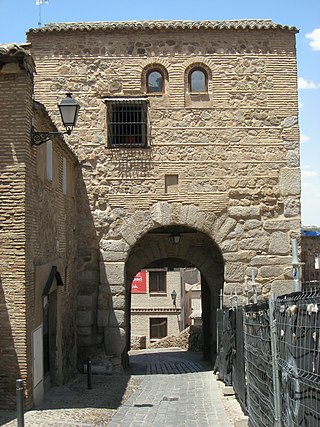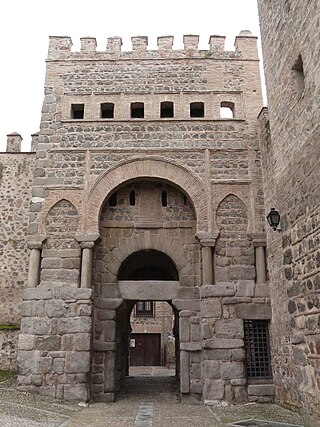
Toledo is a city and municipality of Spain, the capital of the province of Toledo and the de jure seat of the government and parliament of the autonomous community of Castilla–La Mancha.

The Mosque–Cathedral of Córdoba, officially known by its ecclesiastical name of Cathedral of Our Lady of the Assumption, is the cathedral of the Diocese of Córdoba dedicated to the Assumption of Mary and located in the Spanish region of Andalusia. Due to its status as a former mosque, it is also known as the Mezquita and as the Great Mosque of Córdoba.

The Puerta de Alcalá is a Neo-classical gate in the Plaza de la Independencia in Madrid, Spain.

The Puerta del Sol is a public square in Madrid, one of the best known and busiest places in the city. This is the centre of the radial network of Spanish roads. The square also contains the famous clock whose bells mark the traditional eating of the Twelve Grapes and the beginning of a new year. The New Year's celebration has been broadcast live since 31 December 1962 on major radio and television networks including Atresmedia and RTVE.

The Albaicín, also known as Albayzín, is a neighbourhood of Granada, Spain. It is centered around a hill on the north side of the Darro River which passes through the city. The neighbourhood is notable for its historic monuments and for largely retaining its medieval street plan dating back to the Nasrid period, although it nonetheless went through many physical and demographic changes after the end of the Reconquista in 1492. It was declared a World Heritage Site in 1994, as an extension of the historic site of the nearby Alhambra.

The Mosque of Cristo de la Luz is a Catholic chapel and former mosque in Toledo, Spain. It is the one of the ten that existed in the city during the Moorish period. The edifice was then known as Mezquita Bab-al-Mardum, deriving its name from the city gate Bab al-Mardum. It is located near the Puerta del Sol, in an area of the city once called Medina where wealthy Muslims used to live.

The Mezquita de las Tornerías is a Moorish former mosque in Toledo. It was built in the middle of the 11th century on the foundations of Roman architecture, located in the old Muslim neighborhood Arrabal de Francos. Currently it houses the "Center Foundation of Promotion of the Crafts", that can be visited and hosts temporary exhibitions.

The Puerta Bab al-Mardum, or Puerta de Valmardón, is a city gate of Toledo, Spain. It was built in the 10th century and is one of the oldest gates in the city. Its name 'mardum' is Arabic for 'blocked up'. Perhaps because its function was taken over by the Puerta del Sol. The Spanish name Valmardón is a rough, phonetic imitation of the Arabic. 'Mezquita Bab al-Mardum' is another name for the nearby Mosque of Cristo de la Luz.

The Puerta de Bisagra is a city gate of Toledo, Spain.

The Puerta de Bisagra Nueva is the best known city gate of Toledo, Spain.

Puerta del Sol is a city gate of Toledo, Spain, built in the late 14th century by the Knights Hospitaller.

The Puerta del Puente is a Renaissance gate in Córdoba, Andalusia. Built in the 16th century to commemorate a visit to the city by King Philip II, the gateway is located on the site of the previous Roman gates, linking the city with the Roman bridge and the Via Augusta.

The Walls of Felipe IV surrounded the city of Madrid between 1625 and 1868. Philip IV ordered their construction to replace the earlier Walls of Philip II and the Walls del Arrabal, which had already been surpassed by the growth of population of Madrid. These were not defensive walls, but essentially served fiscal and surveillance purposes: to control the access of goods to the city, ensure the collection of taxes, and to monitor who went in and out of Madrid. The materials used for construction were brick, mortar and compacted earth.
The Walls del Arrabal were the third in a set of five walls built around Madrid, now the capital of Spain. There are no remaining ruins of the Walls del Arrabal, leaving some debate as to their extent and the period of their construction. It is possible that the walls were built as early as the 12th century, however they were most likely constructed in 1438. The walls may have been intended to protect people against the plagues that ravaged the city at the time. The walls united the urbanized suburbs of the city and prevented entry of the infected.

Embajadores is an administrative neighborhood (barrio) of Madrid, belonging to the Centro District.

The Puerta del Cambrón is a gate located in the west sector of the Spanish city of Toledo, in Castile-La Mancha. Also called previously "Gate of the Jews" or "Gate of Saint Leocadia", has been speculated The possibility that the name of the gate, del Cambrón, had its origin in the growth of a thorn bush or plant at the top of the ruins of one of the towers, before the last reconstruction of the gate, In 1576. It has the cataloging of Bien de Interés Cultural.

The Alcantara Gate is a city gate located in Toledo, in Castile-La Mancha, Spain. It gives access to the interior of the historic center of the city, passing through its eastern side the surrounding wall. It is in front of the bridge called Puente de Alcántara, that crosses the Tagus river and that in turn is protected by two gates fortified in its ends.

The Templar House in Toledo, is a residence in Castile-La Mancha, Spain. It was built and decorated between the years 1085 and 1114.

The Iglesia de los Santos Justo y Pastor, popularly known as Iglesia de San Justo, is a church located in the city of Toledo. It was founded after the city was taken by King Alfonso VI of León and Castile in the 13th century. The city underwent transformations between the 14th and 18th centuries. This is a religious temple under the invocation of the holy children Justus and Pastor.

The Jewish quarter of Toledo is a district of the city of Toledo, in Castile-La Mancha, Spain. It was the neighborhood in which the Jews lived in the Middle Ages, although they were not obliged to live within it.




















